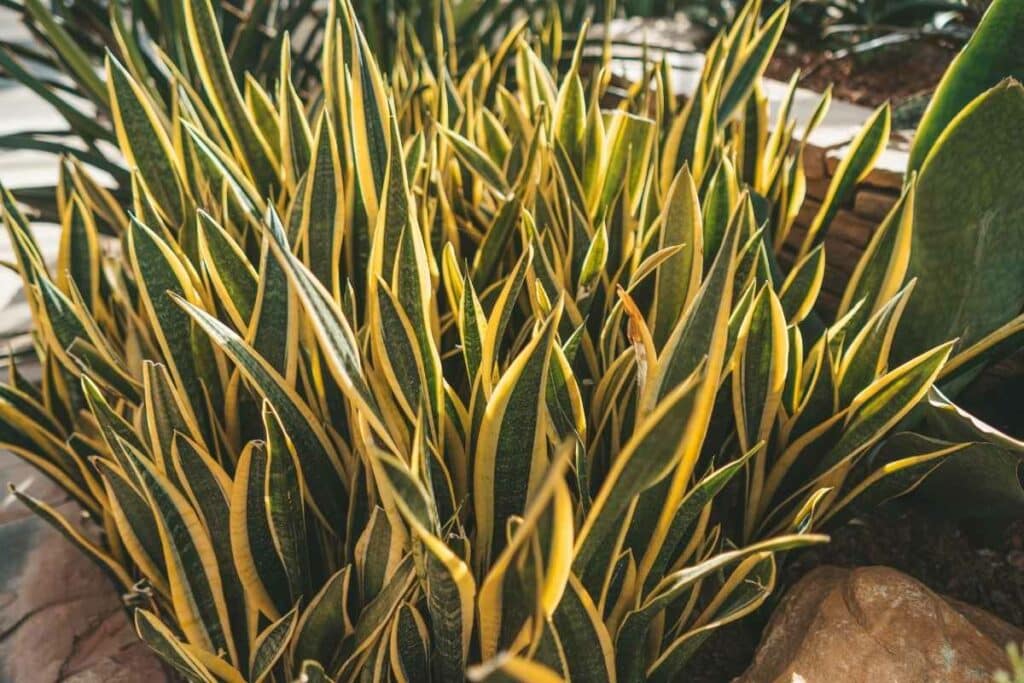Snake plants, also known as Sansevierias plants or mother-in-law’s tongue, are low-maintenance plants usually kept in containers indoors.
In some areas, you can plant them outdoors as well, but the growing conditions have to be right.
In fact, snake plants are some of the easiest plants to grow even if you’re a beginner, which is one of the reasons they’re so popular.
While they can be grown both indoors and outdoors, if you put your snake plant in an outdoor container, there are some things that you’ll need to keep in mind first.
Snake plants do best when kept at a temperature of 70 degrees Fahrenheit to 90 degrees Fahrenheit. This means that if the area you live in gets especially cold during the winter months, you might not be able to keep them outdoors all year long. If you’re in USDA growing zones 9-12, however, you can keep them in containers outdoors or even plant them outside in the ground if you like. If you live in a cooler climate, make sure you bring your snake plants indoors for the winter months.
The Best Way to Grow Snake Plants
Snake plants can be planted outdoors, either in a container or in the ground, as long as you live in an area that doesn’t get too cool during the winter months.

The best place to keep your snake plants is in a sunny spot that gets very good drainage.
If you leave them in a container but put them outside, make sure that the pot has sufficient drainage ability.
If you plant them outside but your soil has a lot of clay in it, spruce up the soil with a little compost first.
Here are some things to remember when growing snake plants:
- Only water the plant about once a week. Snake plants are drought tolerant.
- Don’t let the soil get waterlogged or you’ll risk the roots rotting. If the soil is dry to the touch when you check it, it is time to water the plant again.
- They normally don’t need fertilizer, but you can give them a slow-release fertilizer during their active growing stage, which is in the spring, if you like.
- Snake plants love full sun. This is especially true for the variegated varieties.
- Although they can tolerate frost, snake plants are not frost-hardy, so bring them indoors as soon as the temperatures start to lower.
Dividing Snake Plants
Many growers love to divide their plants in order to grow more of the same plant, and this is easy to do with the snake plant.
Look at the base of the plant for smaller plants called offsets.
When you find them, you can either leave them in place so they’ll form larger clumps or divide them and make additional plants.

If you divide them, make sure that you only do this once every few years.
It is also possible to propagate snake plants if you prefer. Just cut the leaves into sections and place them either in water or a seed-raising mix.
Keep in mind that if you have a variegated snake plant, you probably shouldn’t propagate it because the variegations won’t be as vibrant and colorful as they were before they were cut.
Important to Remind: Leaf propagation is most successful on the varieties of snake plants that have green leaves.
Pests on Your Snake Plants
When snake plants are kept outdoors, there is always the possibility of pests appearing on them.
Some of the most common pests found on snake plants include:
- Mealybugs, which are small fuzzy-looking, white insects that usually attach themselves to the leaves of the plant
- Scale insects, which are tiny and look like small brown lumps on the leaves
- Spider miles, which look like either yellow or brown spots on the leaves
Fortunately, it’s easy to get rid of most of these pests because all you do is wipe them off of the leaves with a damp cloth.
For the ones you’re unable to remove, simply spray the leaves with either an insecticidal soap or neem oil once a week until the pests are gone.
When you spray, try to spray in the evening so the cleaning agent you’re using doesn’t mix with the sun to scorch the leaves.
Snake Plants Contain Flowers
Many people are unaware of this, but snake plants that are kept outside can sometimes bloom and produce cream-colored or white flowers.
They likely won’t produce these flowers every year, but you’ll enjoy it when they do.
The flowers are not only very attractive, growing on a long elegant flower stalk, but they also put out a very nice aroma that most people enjoy.
The flowers themselves are often pollinated by moths, and they produce small orange or red berries after they bloom.
Final Thoughts
There are also different varieties of snake plants, but most of them will reach one to three feet in height. Some varieties get up to five feet high.
If you grow them indoors and wish to move them outdoors, place them in a shady area for one to two weeks before placing them directly in the sun.
This can prevent any problems associated with the shock of two very different light sources.
Also Helpful
- Why Is My Catmint Floppy and How Do I Fix It?
- Can I Put Mulch in the Bottom of My Planter?
- Growing Dicksonia Antarctica in Pots


